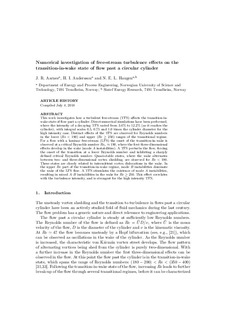Numerical investigation of free-stream turbulence effects on the transition-in-wake state of flow past a circular cylinder
Journal article, Peer reviewed
Accepted version
Permanent lenke
http://hdl.handle.net/11250/2504735Utgivelsesdato
2018Metadata
Vis full innførselSamlinger
Sammendrag
We investigate how a turbulent free-stream (TFS) affects the transition-in-wake state of flow past a cylinder. Direct numerical simulations of a decaying TFS flow past a cylinder have been performed, where the intensity and integral scale of the TFS was varied. Distinct effects of the TFS are observed for Reynolds numbers in the lower (Re < 190) and upper (Re ≥ 250) ranges of the transitional regime. For a flow with a laminar free-stream (LFS), the onset of the transition-in-wake is observed at critical Reynolds number 190, where the first three-dimensional effects develop in the wake (mode A instabilities). A TFS perturbs the flow, forcing the onset of the transition at a lower Reynolds number and inhibiting a sharply defined critical Reynolds number. Quasi-stable states, where the wake alternates between two- and three-dimensional vortex shedding, are observed for Re < 190. These states are closely related to intermittent vortex dislocations in the wake. In the upper Re part of the transition-in-wake regime, mode B instabilities dominate the wake of the LFS flow. A TFS stimulates the existence of mode A instabilities, resulting in mixed A–B instabilities in the wake for Re ≥ 250. This effect correlates with the turbulence intensity. © 2018 Informa UK Limited, trading as Taylor & Francis Group.
